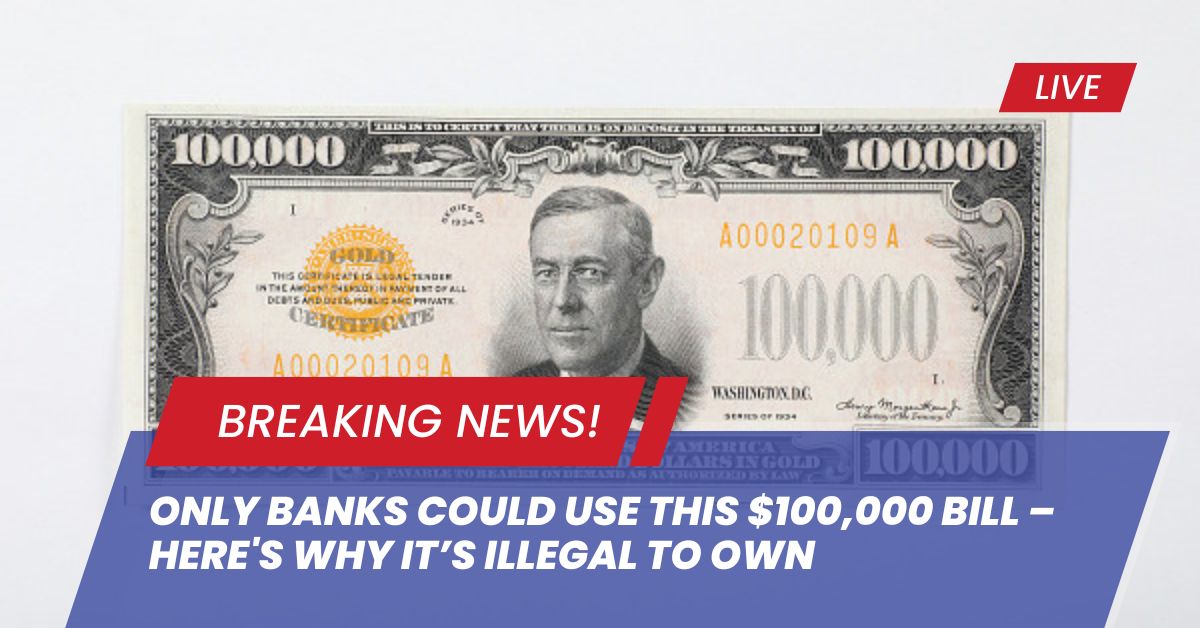What if we told you there’s a $100,000 bill that most Americans have never seen, can’t spend, and aren’t even allowed to own?
No, this isn’t some internet myth or a billionaire’s flex. The $100,000 bill is real — it features a U.S. President, was printed by the Treasury, and could buy a luxury sports car… but there’s a catch: you’ll never legally have one in your wallet.
Here’s the mind-blowing truth behind America’s highest denomination currency — and why it was created for banks only, not people like you and me.
Meet the $100,000 Bill
Printed in 1934, the $100,000 bill features the face of Woodrow Wilson, the 28th President of the United States. It was officially known as a Gold Certificate and marked as Series 1934.
But unlike the $1, $5, or even the ultra-rare $1,000 bills used by the public, the $100,000 note had one very specific job:
It was used only for official transactions between Federal Reserve Banks — kind of like a behind-the-scenes tool for moving massive amounts of money before digital banking existed.
Why You Can’t Own One?
Here’s where it gets spicy:
Even though it’s real U.S. currency, the $100,000 bill is not legal to own as a private citizen.
Why? Because it was never released into general circulation. It was printed strictly for internal government use, and holding one outside of that purpose is against federal law.
So even if you somehow stumble upon one, you can’t sell it, trade it, or legally keep it — it belongs to history, not the public.
But… Does Anyone Still Have One?
There are a few surviving $100,000 bills — and they’re protected like museum artifacts. Some are held by:
- The Smithsonian Institution
- The Federal Reserve Bank archives
- Select U.S. Treasury exhibits
They’re considered non-circulating legal tender, which means they’re technically “real” money — but absolutely off-limits to private collectors.
Why Was It Even Created?
The bill was introduced during the Great Depression under President Franklin D. Roosevelt. At that time, the U.S. was transitioning off the gold standard, and this note represented an equivalent amount of gold stored by the Treasury.
It wasn’t about buying things — it was about clearing massive balances between banks without needing to ship literal tons of gold.
How It Differs From Other Rare Bills?
Unlike the $10,000 or $5,000 bills — which are legal (but rare) to own and collect — the $100,000 note has always been restricted.
- Other large-denomination bills: collectible and highly valuable
- The $100,000 bill: historical, but untouchable
You could spend years building a rare currency collection, but this one bill will always be missing — and that’s part of what makes it legendary.
What It Looks Like?
The bill features:
- A sharp portrait of Woodrow Wilson
- Bold $100,000 text
- Gold-toned seal and serial numbers
- “Gold Certificate” printed across the top
- A legal notice stating: “This certificate is not valid for payment to individuals.”
It looks like something out of a heist movie — but it’s 100% real U.S. history.
Final Thought: The Ultimate Off-Limits Fortune
The $100,000 bill is more than rare — it’s forbidden fruit in the world of currency collecting. While you can hunt down million-dollar pennies or valuable $2 bills, this one note is locked behind the doors of America’s financial institutions.
You can’t own it. You can’t buy it. You can only wonder:
What would it feel like to hold $100,000 in one single bill — and not be allowed to keep it?
Would You Still Want to See One in Person?
Tell us in the comments — and tag someone who’d love to sneak a peek at the $100,000 bill of legend.
